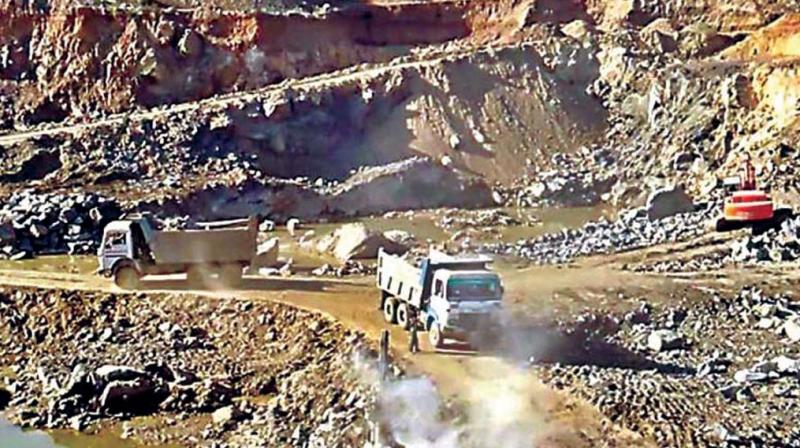Meghalaya mining crisis: illegal, inhuman, anti-ecology
Official inquiries into flooding disasters at approved mines, including Chasnala, have shown serious shortcomings in safety management.

First the facts of the matter:
Disaster struck on December 13 last at a rat-hole coal mine in Jaintia Hills of Meghalaya, in which at least 13 miners got trapped due to a deluge of water rushing into the mine, following the break-down of the chamber due to unscientific illegal mining going on there. Obviously none will be alive today.
Around 5000 such mines, referred to as a rat holes, at the rate of 55 per square kilometre, are being allowed to function in Meghalaya in violation of not just safety norms but a complete prohibition order issued by the National Green Tribunal in 2014. Clearly, the administration did not act to stop unscrupulous operators of the illegal mine from exploiting desperate workers.
Obviously India has not learnt the lessons of the worst mining tragedy in Chasnala near Dhanbad in 1975 in which more than 370 people were killed.
These 5000 mines are owned by dozens of politicos irrespective of parties and hundreds of small time business-men who fund politicians of all hues in Meghalaya. Further, the land for these are bought from local tribal families many of whom are happy with immediate income, forgetting that they are dispossessed of their lands for ever.
Each truck-load of this illegally mined coal has a minimum profit of Rs.1 lac after all expenses, and hence, the Police and administration are well taken care of by the miners. So much so that this spate of mining here is defined as a 'cottage industry' which has limited precautions in law.
Thus there is an enormous politico-miner-bureaucrat-police- transporter nexus which allows this to continue unabated for decades now in spite of several such tragedies till date.
More may continue to die in this unregulated and exploitative industry that sustains livelihoods of the poor and sustains several of Meghalaya’s millionaires—and the state’s economy and politics. Pertinent to note that the Additional chief secretary P.W. Ingty, the official in charge of the mission, went on leave a few days after the crisis broke out. The administration did not cooperate much with the Disaster Relief team of NDRF. It’s hardly surprising because coal mining has for decades been Meghalaya’s dirtiest open secret.
In 2014, the National Green Tribunal (NGT) banned coal mining in Meghalaya. Despite an attempt in 2012 to introduce regulations through a mineral policy, it remained full of holes and, in practice, winks. NGT permitted the transportation of coal already mined in this organized-unorganized sector for which the state and several miners realized benefits. However, fresh mining continued.
Meanwhile, the labour behind it remained a grey area of poverty-stricken locals, migrants from poorer districts of Assam, and from adjacent districts of Bangladesh, such as Sylhet, Sunamganj, Netrokona and Mymensingh.
Mining Industry Flawed in India:
Official inquiries into flooding disasters at approved mines, including Chasnala, have shown serious shortcomings in safety management. Two years ago, a landslip at an open cast mine in Goda, Jharkhand, killed 23 people, raising questions about the rigour of the technical assessment done prior to expansion of extraction activity. A study on three big flooding accidents published in 2016 by the IIT-Indian School of Mines, Dhanbad, concluded that the official approach of fixing responsibility on human error was flawed, since it did not try to identify the root cause. There is little evidence to show that pre-mining surveys and safety protocols are incorporating such advice. The case of illegal mines falls in a different category. Meghalaya is a far worse violation of law, ecology, human rights et al than Chasnala or Goda.
Political Stands in Meghalaya:
While this illegal mining in Meghalaya flourished under the watch of Congress led earlier state governments, when finally NGT banned it, it is also to be noted that Congress in the last general election stood for legalized mining and nationalization of the mines and bringing them under Coal India Limited. It claims that it lost the election a year ago primarily on this issue.
BJP, on its part, has officially declared in its manifesto to open up the mines which were closed during the elections following judicial activism, which gave them the money and support of the miners.
The current Chief Minister, the young 'visionary' Conrad Sangma of National People's Party, had gone to the Supreme Court for cancelling the NGT ban and have some form of regulated mining instead, and is ruling today with the support of the BJP. That shows the dominant political narrative here.
Current Imbroglio:
After disaster struck, it was incumbent on the Meghalaya government to launch an immediate rescue effort. But it did not possess the equipment to dewater the stricken mine quickly, and did not show any urgency in requisitioning it from elsewhere, in spite of the involvement of the National Disaster Response Force. Now that the crisis is more than a month old with no hope of any survivor, the least it can do is give exemplary compensation to the hapless families of the mining labourers who are killed inside, and come heavy on rathole mining in Meghalaya. None in the horizon except a spate of blame-game between Congress and BJP today.
The crisis today is beyond mining and it engulfs river water in Northeast, too. In August 2018, an NGT bench upheld the 2014 order, which began with a public interest litigation filed by an Assam-based non-government organization representing the Dimasa people, who complained of water bodies being poisoned because of mining in Meghalaya. The 2018 order also noted that illegal mining had continued in this extra-legal industry.
Way Out:
One, implement NGT ban on private illegal mining in Meghalaya in full force whatever be the political costs. This has also polluted three fresh water rivers of Meghalaya as already pointed in reports of CAG and in several ecological surveys.
Two, mining in Meghalaya is entangled in questions about tribal rights to land and customary laws. The state falls under the Sixth Schedule, which protects these rights and autonomies, insulating it from national laws to a certain degree. But the state is not officially exempt from the Coal Mines (Nationalisation) Act of 1973, which gives the Indian state ownership and control of underground minerals, neither has the state government applied for exemption. This is national property and if at all has to be mined, it must be done by a Public Sector Undertaking, like the Coal India Limited, with precautions, modern technology, safety measures for labourers, and social security and insurance for their families in case of a disaster. Only skilled labour will then be engaged unlike the hapless jobless unskilled labour today. A proposal to this effect was finalised between CIL and Meghalaya govt, but the same powerful nexus then shelved it.
Three, mining industry as a whole needs a complete overhaul given the spate of illegal sand mining in MP, gold mining in Karnataka, KG Basin oil mining, and ores mining in Goa. A new modern approach, technology, safety measures and social security regime is needed for mining, and not just satiating the greed for quick money, whether for the government or for private coffers.
Four, while the entire world is moving away from fossil fuel, why are we so eager for coal which is anti-ecology, harmful for public health, dangerous to mine, and creates a mafia at all places where they exist? These are the times of non-conventional energy, which are actually the conventional ones, with wind and biomass being abundant in Himalayan range including Meghalaya, and tidal and solar energy sources being abundant in the coastal India. One time investments on these sources of energy can create long-term unabated sources of energy which is different from fossil fuels with limited and fixed supply.
It needs a different policy approach to go beyond the exigencies of the moment and the greed of those in power.

